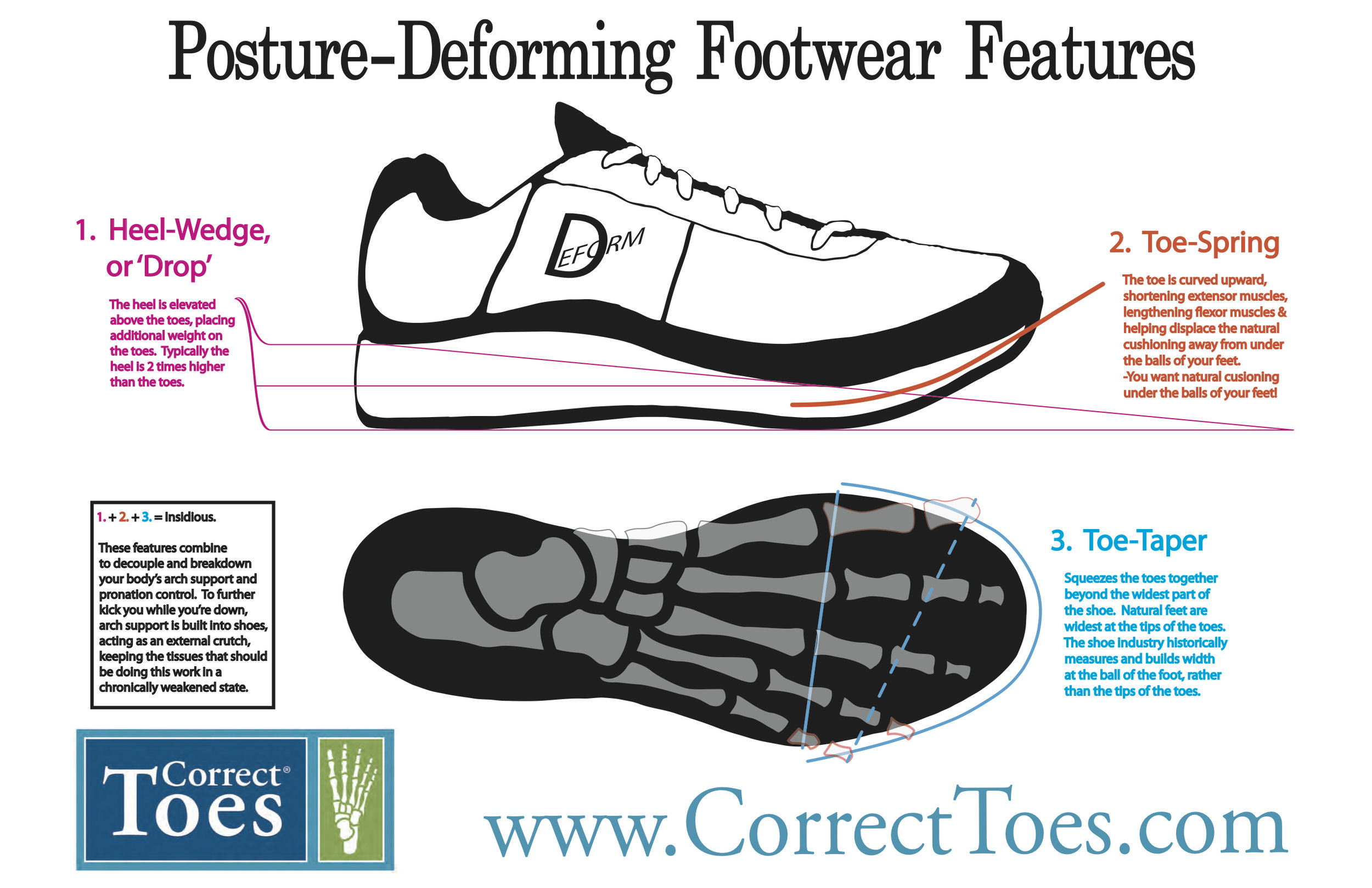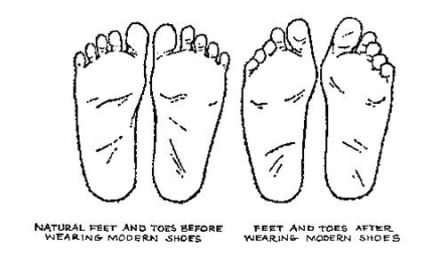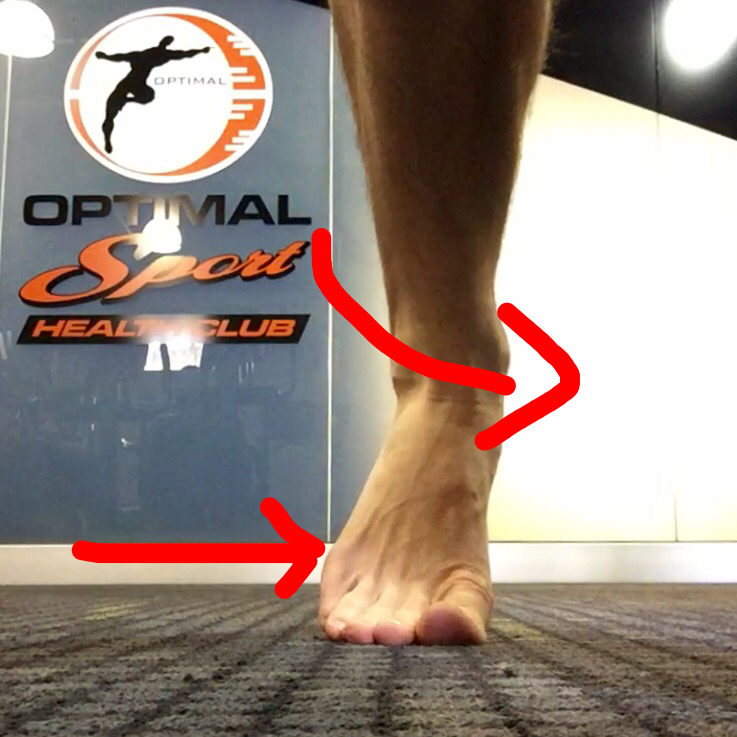5 Shoe Characteristics That Are Ruining Your Life
 Disfigurement? Really? That's pretty harsh statement, but it's true over the long term. And I'm not just calling out the obvious high-heeled, pointy-toed, fashionable shoes that we all KNOW aren't good for foot health.
Disfigurement? Really? That's pretty harsh statement, but it's true over the long term. And I'm not just calling out the obvious high-heeled, pointy-toed, fashionable shoes that we all KNOW aren't good for foot health.
The vast majority of casual AND training shoes on the market are not designed to allow our foot to function optimally – even though they may be marketed as such.
Let's take a look at the average running shoe, a shoe that most people think are comfortable and therefore must be good – or at least “not bad” - for our feet. Here are some typical features:
- A tapered toe box – to squeeze your toes together and prevent them from splaying naturally.
- An elevated heel – that subtly shifts our body mass forward and causes our entire body to react to this shift by compensating. Knee pain anyone? Additionally, our lower leg muscles can never fully lengthen. How about tight calves? Foot cramps?
- A toe spring – this causes the toes to bend upwards.
- Lots of cushioning – to reduce your awareness of the ground and cause you to overstride, no doubt.
- Too much stiffness in the sole – which prevents one of the most mobile parts of our body from experiencing movement.
Here's an awesome visual showing some of these characteristics. Click on the image for a more clear view!
The totality of these characteristics creates a ton of issues as we age and ignorantly wear our ill-fitting shoes all day, every day. So to that end, I'd like to bring more awareness as to what to look for when choosing a shoe so you can, at the very least, make a more informed decision.
Today I want to dig into #1 on the list, the tapered toe box, and there's a few reasons this is so problematic.
For one, it *may* create a deformity over time. Toes are supposed to be the widest part of the foot. Look down at your foot right now. Is that the case? Even if you don't have a bunion, chances are your big toe is not pointing straight ahead, perfectly aligned with the metatarsal bone. It's more likely to be pointing inward (towards the second toe) to some degree.
It's been found that in unshod culture, only 2% of the female population has bunions compared with 50% in shod cultures. Now, does wearing a shoe with a tapered toe box guarantee you'll have bunions? No, because bunions aren't just a result of wearing tight shoes; how you walk and your genetics also play significant roles.
Real quick, in simple terms: Pronation = foot rolls inward. Supination = foot rolls outward.
Your foot should make initial contact with the ground in a supinated position. Next, your foot pronates as it flattens out. Then, to propel yourself, the foot should re-supinate. So, supinate – pronate – supinate.
The big issue in my mind is that the tapered toe box restricts the ability for the foot to properly re-supinate out of a pronated position. Your toes are supposed to spread slightly during that phase, yet the toe box keeps the toes smushed together. Now THAT may cause a bunion over time. And most definitely it will reduce the amount of power you get out of your stride.
It may help to see a visual of pronation and re-supination...
In this picture, my foot is “stuck in a pronated position” at toe-off. You can tell (and I could tell because it felt terrible) that all of my weight was on my big toe side of the foot because, if you look closely, you'll see the ball of my foot on the little toe side is off the ground.
This is NOT good. Imagine, all of your propulsive power loaded onto that single point. Its no wonder that, after years of 'doing it this way', one might develop a bunion to help create more stable base from which to push off.
Compare to this photo of my foot which has left the pronation phase and is re-supinating. You can see that both the 1st and 5th metatarsal heads (ball of foot) are connected to the floor at this point and I'm primed for a powerful push off.
A few brands to check out include Altra (usually my number one recommendation for runners), New Balance (only their rapidly disappearing 'Minimus' line), Merrell (the "bare-access" line), Vivo Barefoot, and Lems for casual/walking.
Anyway, unfortunately I can't say that simply switching to shoes that allow for the possibility of some toe splay is the complete solution, but it IS a meaningful one. And hopefully, after reading this post you have a better understanding about why you need to buy shoes that don't have a tapered toe box.
**Caveat! If you make a change in footwear, it's a big deal for your whole body. Depending on where you're coming from, it may be wise to make small changes over time versus going from a maximalist shoe down to a more minimalist shoe. Start with wearing shoes with an anatomically designed toe box!




